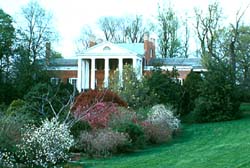
Oak Hill is a mansion and plantation located in Aldie, Virginia that was for 22 years a home of Founding Father James Monroe, the fifth U.S. President. It is located approximately 9 miles (14 km) south of Leesburg on U.S. Route 15, in an unincorporated area of Loudoun County, Virginia. Its entrance is 10,300 feet (3,100 m) north of Gilberts Corner, the intersection of 15 with U.S. Route 50. It is a National Historic Landmark, but privately owned and not open to the public.

The John Adams Birthplace is a historic house at 133 Franklin Street in Quincy, Massachusetts. It is the saltbox home in which Founding Father and second president of the United States, John Adams, was born in 1735. The house was designated a National Historic Landmark in 1960, and is listed on the National Register of Historic Places. It is now administered by the National Park Service as part of the Adams National Historical Park, and is open for guided tours.
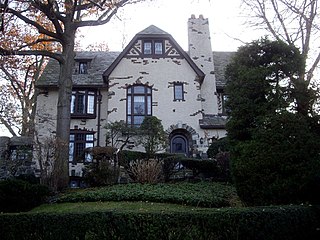
Ralph Johnson Bunche House, the last home of American diplomat Ralph Bunche (1903–1971), is a National Historic Landmark in New York City. It is a single-family home built in 1927 in the neo-Tudor style, and is located at 115–24 Grosvenor Road, Kew Gardens, Queens. It is named after Ralph Bunche, who helped to found the United Nations in 1945. In 1950, he became the first African American and first person of color to win the Nobel Peace Prize, for mediating armistice agreements between Israel and its neighboring countries.

The William Monroe Trotter House is a historic house at 97 Sawyer Avenue, atop Jones Hill in the Dorchester neighborhood of Boston. It was the home of African-American journalist and civil rights activist William Monroe Trotter (1872–1934). He and his wife Geraldine Louise Pindell moved into the two-story wood-frame home when they were married in June 1899. The house was designated a National Historic Landmark in 1976 for its association with Trotter, whose activism was influential in the founding of the National Association for the Advancement of Colored People.

The Burton K. Wheeler House is a historic house at 1232 East 2nd Street in Butte, Montana, United States. Built about 1923, this modest working-class house was for many years the home of politician Burton K. Wheeler (1882–1975), a Democrat who in 1924 ran for United States Vice President on the Progressive Party ticket. His house was declared a National Historic Landmark in 1976.

The Reynolds-Morris House is an historic house which is located at 225 South 8th Street in the Washington Square West neighborhood of Philadelphia, Pennsylvania. Built between 1786 and 1787 by John and William Reynolds, it is a well-preserved example of a Philadelphia Georgian townhouse.

The James Monroe Museum and Memorial Library is a historic museum at 908 Charles Street in Fredericksburg, Virginia. It is located on the site of the James Monroe Law Office, used by future United States President James Monroe from 1786 to 1789. It was declared a National Historic Landmark in 1966. It is now owned by the Commonwealth of Virginia and operated by the University of Mary Washington. The museum features original objects and memorabilia related to James Monroe, and includes items relating to other members of his family, including dresses worn by First Lady Elizabeth Monroe.
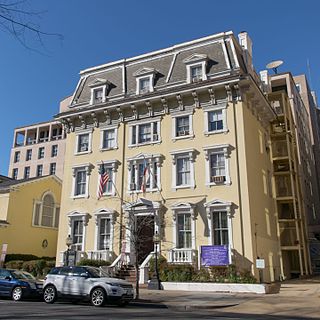
Ashburton House, also known as St. John's Church Parish House or the British Legation, is a historic house at 1525 H Street NW, on Lafayette Square in Washington, D.C. Built in 1836, it is notable as the residence of Lord Ashburton in 1842, during which time negotiations took place there culminating the Webster–Ashburton Treaty. This settled a long list of border disputes between the U.S. and the British provinces that are now Canada, and ended the Aroostook War. It was declared a National Historic Landmark in 1973. It presently serves as the parish house for St. John's Episcopal Church.

Newton D. Baker House, also known as Jacqueline Kennedy House, is a historic house at 3017 N Street NW in Washington, D.C. Built in 1794, it was home of Newton D. Baker, who was Secretary of War, during 1916–1920, while "he presided over America's mass mobilization of men and material in World War I. After the assassination of president John F. Kennedy in 1963, Jacqueline Kennedy purchased the house and lived here for about a year.

The Blanche K. Bruce House is a historic house at 909 M Street NW in Washington, D.C. Built in 1865, it was a home of slave-born Blanche K. Bruce, who was the first African-American to serve a full term in the U.S. Senate. It was declared a National Historic Landmark in 1975.
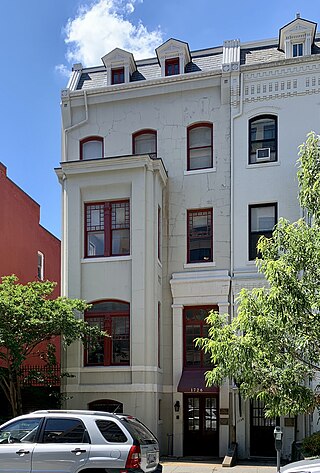
The Elliott Coues House is a historic house at 1726 N Street NW, in the Dupont Circle neighborhood of Washington, D.C. Built about 1880, it was the home of 19th-century historian and ornithologist Elliott Coues (1842–99) from about 1887 until his death. Coues helped found the American Ornithologists' Union in 1883 and edited about 15 volumes of journals, memoirs, and diaries by famous Western explorers and fur traders. The house was declared a National Historic Landmark in 1975.

The General Oliver Otis Howard House, also known as Howard Hall, is a historic house, and the oldest surviving building on the campus of Howard University, in Washington, D.C. Built in 1867, it was the home of General Oliver Otis Howard, the university founder and its third president. The house was declared a National Historic Landmark in 1974. It faces Georgia Avenue NW, just north of Howard Place.

Charles Evans Hughes House is a historic house at 2223 R Street, NW in the Sheridan-Kalorama neighborhood of Washington, D.C. Built in 1907, it was from 1930 to 1948 the home of Charles Evans Hughes (1862–1948), a prominent Republican politician and from 1930 to 1941 the Chief Justice of the United States. It was declared a National Historic Landmark in 1972 and is a contributing property to the Sheridan-Kalorama Historic District. It presently serves as the official residence of the Ambassador of Myanmar to the United States.
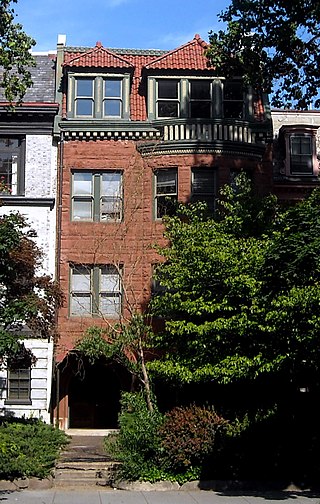
The Robert Simpson Woodward House is a former residence located at 1513 16th Street, NW in the Dupont Circle neighborhood of Washington, D.C. From 1904 until 1914, it was a home of geologist Robert Simpson Woodward (1849–1924), the first president of the Carnegie Institution and a highly regarded scientist and science administrator. The building currently serves as the Capital Research Center headquarters. It was declared a National Historic Landmark in 1976 and designated a contributing property to the Sixteenth Street Historic District in 1978.

The Oscar W. Underwood House is a historic house located in the Foggy Bottom neighborhood Northwest, Washington, D.C. It is nationally significant for its association with Major Archibald Butt, and painter Francis Davis Millet – both of whom died in the Titanic disaster on April 15, 1912 – and also Alabama politician Oscar Underwood (1862–1929) who lived there 1914–1925. It was the first long-term home of the Washington College of Law, the nation's first law school founded and run by women. The property was declared a National Historic Landmark in 1976. The building presently houses a legal aid clinic operated by George Washington University.

The Mary Church Terrell House is a historic house at 326 T Street NW in Washington, D.C. It was a home of civil rights leader Mary Church Terrell (1863–1954), the first black woman to serve on an American school board, and a leading force in the desegregation of public accommodations in the nation's capital. Her home in the LeDroit Park section of Washington, DC was declared a National Historic Landmark in 1975. The building is a contributing property in the LeDroit Park Historic District.
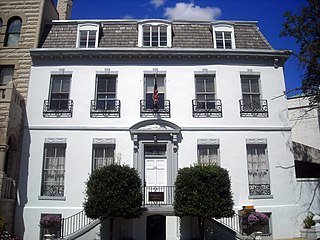
The Hiram W. Johnson House, also known as Mountjoy Bayly House, Chaplains Memorial Building or Parkington, is an historic house at 122 Maryland Avenue, Northeast, Washington, D.C., in the Capitol Hill neighborhood. Built about 1822, it is most notable as the home of Hiram Johnson (1866–1945), a prominent force in the Progressive Party of the early 20th century and its vice presidential candidate under Theodore Roosevelt in the 1912 election. It was declared a National Historic Landmark in 1976, and contributing property to the Capitol Hill Historic District.

The Sam Rayburn House Museum is a historic house museum at 890 West Texas State Highway 56 in Bonham, Fannin, Texas. Built in 1916, it was home to Sam Rayburn (1882-1961), a famously effective Speaker of the United States House of Representatives. It was declared a National Historic Landmark in 1976. Since 1972, it has been operated as a museum and state historic site by the Texas Historical Commission.

The McCarthy House in Virginia City, Nevada was built in 1875 before the Virginia City's Great Fire of October 26, 1875 but, downhill from commercial C Street, it survived the fire. It is a gable-front 1+1⁄2-story house with shiplap siding.
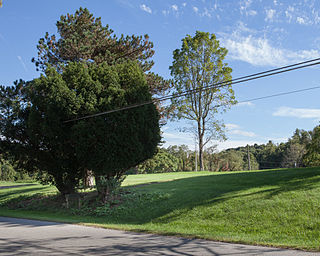
The Harrison House was an historic building which was located in Centerville, Pennsylvania.





















